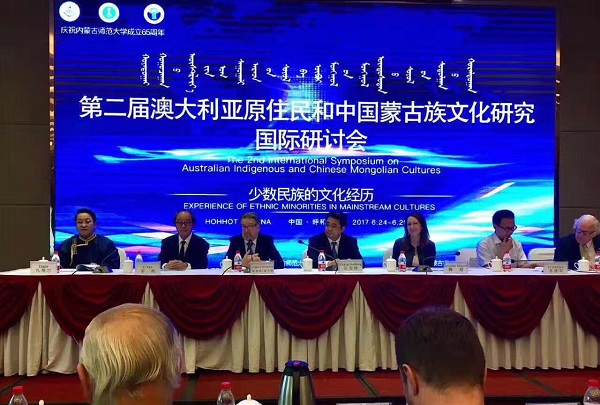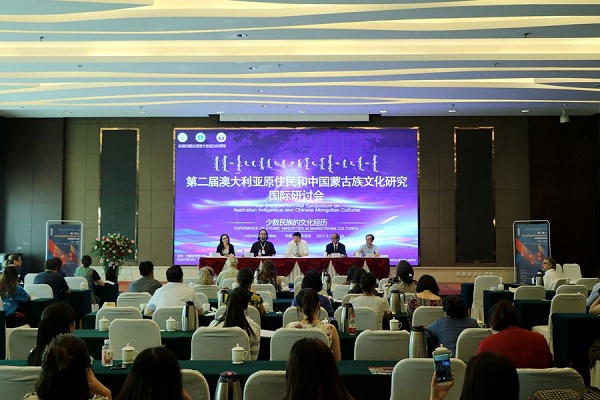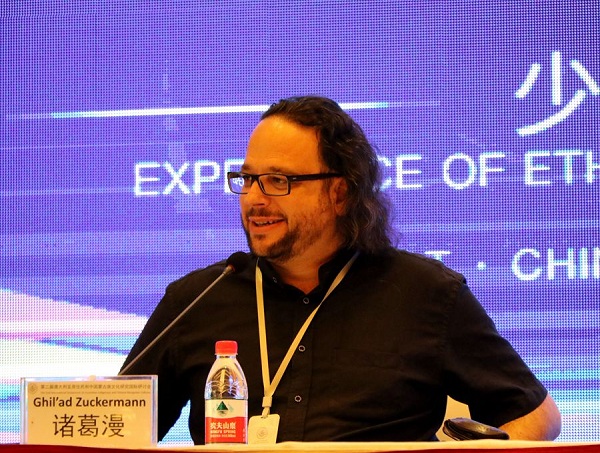IMNU holds symposium on Aborigine and Mongolian cultures

Academics from China and Australia recently assembled at Inner Mongolia Normal University (IMNU) to investigate the indigenous culture of Australia’s Aborigines and the Mongolian ethnic group.
The 2nd International Symposium on Australian Indigenous and Chinese Mongolian Cultures took place in Hohhot on June 24. It aimed to gather university experts together to discuss the historical and cultural experience of ethnic minorities.
Attendees included Jennifer Mason, political councilor of the Australian Embassy; Greg McCarthy, BHP Billiton Chair of Australian Studies at Peking University and professor of political science at the University of Western Australia; Colin Mackerras, emeritus professor of Griffith University and the visiting professor of Beijing Foreign Studies University (BFSU) and Renmin University of China; and Bill Gammage, professor of the Humanities Research Center at Australian National University.
Experts from China included Li Jianjun, secretary general of the Chinese Association for Australian Studies and director of the Center for Australian Studies at BFSU; Li Yao, honorary doctor in arts at Sydney University and visiting professor of BFSU and IMNU; and Zha Ge’er, deputy president of the Chinese Mongolian Philological Association and professor of Inner Mongolia Folklore Society.
Zhang Haifeng, vice-president of IMNU, gave a welcoming speech at the opening ceremony. Zhang emphasized the significance of the symposium and the confidence in future cooperations with experts from Austraulia.
Professor McCarthy pointed out that in the dialectical mode of thinking, the relationship between ethnic minorities and other ethnic groups, as well as between cultures and civilizations, has always been interrelated and interdependent.
Counselor Mason congratulated the IMNU Australian Studies Center for hosting the seminar through inviting academic experts from Australia and China to exchange opinions concerning ethnic culture and conduct comparative research into the subject. Mason praised the effort IMNU has made in studying indigenous Australians and conveyed her hopes for dynamic discussion and research in the future.
As part of the event, Siqin Bilige, arts instructor at IMNU Conservatory of Music, performed the long tune (traditional Mongolian folk singing). And Matthew Doyle, cultural counselor of Australia’s Bangarra Troupe, played the didgeridoo at the ceremony –– a traditional instrument invented by indigenous Australians.
A total of 26 experts expressed their views on a variety of subjects, including the classification of Mongolian folk customs, the historical origins of Mongolian long tune, and the renaissance of native languages spoken by Aborigines.
The closing ceremony was attended by Zhao Donghai, vice-president of IMNU; Ghil'ad Zuckermann, professor of Linguistics and the Endangered Language Department at the University of Adelaide; and Wu Haiyan, director of IMNU Australian Studies Center.
The symposium has promoted the relationship between China and Australia as well as cross-cultural academic research. It has provided a platform for bilateral experts to communicate and thus enhance understanding and cognition.

The 2nd International Symposium on Australian Indigenous and Chinese Mongolian Cultures takes place at Inner Mongolia Normal University in Hohhot. [Photo by Yuan Hui/chinadaily.com.cn]

Scholars from Australia and China discuss the indigenous culture of Australia’s Aborigines and Chinese Mongolian ethnic group during the symposium. [Photo/IMNU]

Professor Ghil’ad Zuckermann, gives a speech at the 2nd International Symposium on Australian Indigenous and Chinese Mongolian Cultures held in Hohhot. [Photo/IMNU]







